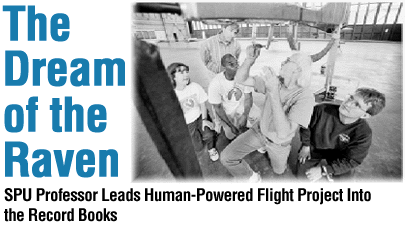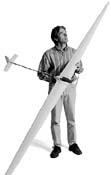Connie McDougall
Photos by
James Prichard

We've all had "flying dreams" in which we float as easily as we walk, magically propelled through the air by our own will. But for some people, human-powered flight isn't relegated to nighttime reveries. These individuals doggedly pursue the dream during waking hours as well.
Anchored in science and math, sweetened by its quixotic nature, human-powered flight has captured the imaginations of academics everywhere, including Seattle Pacific University Professor of Physical Education Dan Tripps. He is deeply involved in the next attempt to set a world record in human-powered flight, as are many of his students.
It's called the Raven Project, an effort that has united hundreds of volunteers, educators and students in the pursuit of a single dream. If all goes as planned, the dream becomes a reality very soon. Sometime this winter, the Raven will take off from Boundary Bay, Canada, and fly 100 miles south to Seattle's Elliott Bay, having spent five hours in the air powered only by one furiously pedaling person.
If successful, the Raven Project will take the world record for human-powered flight, an honor held by MIT since 1988. That flight covered just over 71 miles across the Mediterranean.
It's an enormous challenge, says Tripps, the Raven Project's program director. "But that's why I like it. This is about discovery. It's never been done before."
Tripps also heads the training program for the Raven's pilot/athletes, a challenge that has proved to be far more difficult than anyone expected, in part because of the plane's design. Observes Tripps wryly, "Engineers never build things for people."
The Raven is built for flying. Thirty feet long, with a wingspan of 115 feet and weighing only 90 pounds, it's an aerodynamic wonder, innovative in many ways, not the least of which is the cockpit. In an effort to reduce drag, Boeing engineer and Raven designer Paul Illian gave the plane a sleek, low profile. The cockpit barely protrudes above the fuselage. Thus, drag is greatly reduced, but the pilot -- pedaling a crankshaft that turns the propeller -- is forced to keep the plane up while lying down.
"There's no major research on a recumbent pilot," Tripps says, but it's clear they have their work cut out for them. "There's a 20 percent loss of energy in the supine position," he explains. "We can't get the heart rate up as high. Pilots can't take in as much oxygen so they can't produce as much power." In addition, stress is placed on a set of muscles not accustomed to hard work. Lying down simply isn't the most efficient way to turn a gear.
In simulator tests conducted at SPU, athletes have pedaled hard enough to "take off," and have tried to sustain enough energy to keep the plane aloft. "They have to overcome enormous inertia," says Tripps. "It takes about 300 watts of power just to get airborne, then the pilot has to maintain about 180 watts to fly."
He admits that the human body can only work that hard for a limited time. "When the pilot gets to Seattle, he or she will just be hanging on."
Tripps welcomes the help of interested Seattle Pacific students on the Raven Project. One of them, 1998 electrical engineering graduate Paul Ringsrud, designed a way of getting liquids into the pilot. Ringsrud's main problem: keeping 15 pounds of liquid balanced during flight.
First the team tried dangling a couple of water sacks
on the spar in front of the pilot. "But that didn't work," says Ringsrud. "It was like having two milk jugs swinging in
your face."

After trying several options, his solution was to divide the water equally into two Mylar bladders, each one secure inside a support on either side of the cockpit. A tube runs from each bag through a "T" junction, connecting to a third tube from which the pilot drinks.
"Paul (Illian) kept telling me, 'Keep it simple, keep it simple,'" says Ringsrud. "And he was right." The highlight for Ringsrud was working with a "great engineer" like Illian. "The Raven is his brainchild and it was a lot of fun."
Last year, two other 1998 SPU graduates, Don Webb and Tara Workman, helped screen and train the athlete/pilots. In addition, Webb helped build molds for the wings, and Workman volunteered on weekends for flight tests.
They, like so many others, were caught up in the Raven quest. "There are engineers, athletes, bankers, students -- a lot of different kinds of people involved," says Workman. "It's really an incredible project. And to think the human body can do this kind of feat. These are two awesome machines working together."
Webb was impressed with the project's boldness. "This is being a part of history," he says.
Their experience is precisely what Raven creator Illian had in mind when he began the project more than ten years ago. "I wanted to build a network of universities and students. I wanted them to put aside their isolation and work together, and I thought it would take a big, snazzy project like this to do it."
To a large extent, that's happened. Students and faculty from 11 undergraduate institutions in the Northwest, people from more than 30 businesses and 11 professional societies, as well as more than 400 volunteers, have all contributed to one goal -- get this bird in the air.
Frustrations abound. As soon as one technical problem is solved, another pops up. There is a chronic, critical need for funding. Recently, the huge plane had to be packed up and taken out of its Sand Point hangar to make way for a skateboard exhibition. But no one involved seems to doubt that one day, very soon, the Raven will lift her thin arms and take to the skies, her human engine pedaling like crazy inside.
And when the deed is done, they'll take the Raven on the road, and show school kids what math and science are really about.
Someday, when the plane is exhausted and battered, they'll move it to the Museum of Flight in Seattle. Placed on permanent display, the Raven will be a testament to what dreams are made of.
![]()

| Please read our
disclaimer.
Send any questions, comments or correspondence about Response to
jgilnett@spu.edu or call 206-281-2051. Copyright © 1999 University Communications,Seattle Pacific University.
Seattle Pacific University |